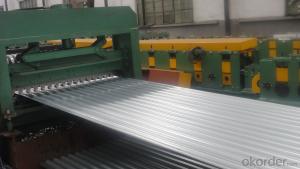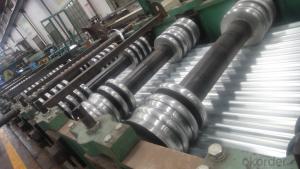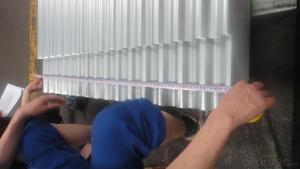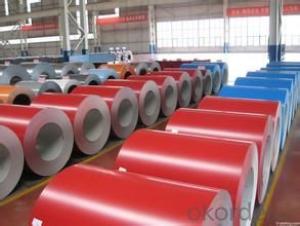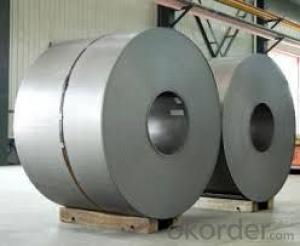0.12-1.2mm galvanized sheet price metal roofing material galvanized corrugated iron sheet
- Loading Port:
- Shanghai
- Payment Terms:
- TT OR LC
- Min Order Qty:
- 10 m.t.
- Supply Capability:
- 100000 m.t./month
OKorder Service Pledge
Quality Product, Order Online Tracking, Timely Delivery
OKorder Financial Service
Credit Rating, Credit Services, Credit Purchasing
You Might Also Like
0.12-1.2mm galvanized sheet price metal roofing material galvanized corrugated iron sheet
1> thickness: 0.12mm - 4.5mm
2> width:762mm/914mm/1200mm
3> length:Any length
4> basic material: Galvanized steel sheet, Aluzinc coated steel sheet, Aluminum steel sheet, Prepainted galvanized steel sheet, Prepainted aluzinc steel sheet
5> Zinc (Al) coating: 40g/m2 - 270g/m2
6> shape: corrugated/ trapezoid/Glazed
7> mainly usage: roof and wall
8> Package: standard export package or as customer's requirement
- Q:How do steel sheets perform in high-temperature environments?
- Steel sheets perform well in high-temperature environments due to their high melting point and excellent heat resistance. They retain their strength and structural integrity, making them suitable for various applications such as furnace linings, heat exchangers, and industrial ovens. However, prolonged exposure to extremely high temperatures can cause some degradation, such as oxidation or loss of mechanical properties, so appropriate alloying and protective coatings may be necessary for optimal performance.
- Q:Can steel sheets be used in furniture applications?
- Yes, steel sheets can be used in furniture applications. They are commonly used for creating sturdy and durable furniture pieces like tables, chairs, and shelves. Steel sheets provide strength, stability, and a modern aesthetic to furniture designs.
- Q:How do steel sheets compare to aluminum sheets in terms of strength?
- In general, steel sheets exhibit greater strength than aluminum sheets. Steel possesses a reputation for its remarkable tensile strength, enabling it to endure substantial forces without distorting or fracturing. Conversely, aluminum sheets demonstrate lower tensile strength and are inclined to bend or distort when subjected to heavy loads. Nevertheless, it is important to acknowledge that aluminum sheets can still possess sufficient strength for numerous applications, particularly when taking into account their lower density when compared to steel. Moreover, aluminum sheets possess the advantage of being lighter in weight, resistant to corrosion, and exhibiting superior thermal conductivity in relation to steel sheets. Consequently, the decision between steel and aluminum sheets hinges upon the specific requirements of the project, taking into consideration factors such as strength, weight, resistance to corrosion, and thermal properties.
- Q:Can steel sheets be painted after installation?
- Yes, steel sheets can be painted after installation. Painting steel sheets after installation is a common practice to enhance their appearance and protect them from rust and corrosion. However, it is important to ensure that the surface is clean and free from any contaminants before applying paint. Proper surface preparation, such as cleaning and sanding, is crucial to promote adhesion and ensure a long-lasting finish. It is also recommended to use a primer specifically designed for steel surfaces before applying the desired paint color. Additionally, selecting a high-quality paint that is suitable for exterior or industrial applications will help to provide the best results and durability.
- Q:Are steel sheets suitable for magnetic shielding applications?
- Yes, steel sheets are suitable for magnetic shielding applications.
- Q:Can steel sheets be recycled multiple times?
- Yes, steel sheets can be recycled multiple times. Steel is one of the most recycled materials in the world due to its durability and recyclability. When steel sheets reach the end of their useful life, they can be collected, melted down, and reprocessed into new steel products. This process can be repeated numerous times without compromising the quality of the steel. Recycling steel sheets not only conserves natural resources but also reduces energy consumption and greenhouse gas emissions associated with the production of new steel.
- Q:Bathroom washing machine, galvanized steel and color steel which good?
- Color steel plate is coated with color coating on the surface of the steel plate, without changing the nature of the steel plate, coating scraping will reveal inside the steel plate
- Q:What is the process of applying fire-resistant coatings to steel sheets?
- The process of applying fire-resistant coatings to steel sheets usually involves cleaning and preparing the surface of the steel sheets to ensure optimal adhesion. Then, a fire-resistant coating is applied using techniques such as spraying, rolling, or brushing. The coating is left to dry or cure, depending on the specific product, and may require multiple coats for desired protection. The coated steel sheets are then ready to be used in applications where fire resistance is required.
- Q:Can steel sheets be used for manufacturing electronics?
- Yes, steel sheets can be used for manufacturing certain electronic components such as chassis and enclosures, as they provide durability and protection. However, they are not commonly used for the internal circuitry or sensitive electronic parts due to their magnetic properties and conductivity limitations compared to other materials like copper or aluminum.
- Q:What is the difference between a hot rolled and pickled steel sheet?
- A hot rolled steel sheet is produced by heating the steel above its recrystallization temperature, typically around 1700°F (926°C), and then rolling the heated material into a desired shape or thickness. This process gives the steel a characteristic scale or oxide layer on its surface. On the other hand, a pickled steel sheet undergoes an additional step called pickling, which involves removing the scale or oxide layer that forms during the hot rolling process. Pickling is typically done by immersing the steel sheet in an acid bath, such as hydrochloric acid, to dissolve the scale. The main difference between a hot rolled and pickled steel sheet lies in the surface finish and cleanliness. A hot rolled steel sheet will have a rougher surface due to the presence of the scale, which can be visually unappealing and may require additional processing or finishing. In contrast, a pickled steel sheet will have a smoother and cleaner surface since the scale has been removed. Another difference is the corrosion resistance of the two types of steel sheets. The presence of the scale on hot rolled steel can make it more susceptible to corrosion, especially in humid or corrosive environments. Meanwhile, pickled steel has a better resistance to corrosion due to the removal of the scale and the subsequent application of a protective coating or treatment. In terms of applications, hot rolled steel sheets are commonly used in structural components, construction materials, and general fabrication where surface finish is not critical. Pickled steel sheets, on the other hand, are often preferred in industries such as automotive, appliances, and manufacturing, where a smooth and clean surface is desired for further processing or finishing. In summary, the difference between a hot rolled and pickled steel sheet lies in the surface finish, cleanliness, and corrosion resistance. While hot rolled steel has a rougher surface due to the presence of scale, pickled steel undergoes an acid bath to remove the scale, resulting in a smoother and cleaner surface. Pickled steel also offers better resistance to corrosion and is preferred in applications where a high-quality surface finish is required.
1. Manufacturer Overview |
|
|---|---|
| Location | |
| Year Established | |
| Annual Output Value | |
| Main Markets | |
| Company Certifications | |
2. Manufacturer Certificates |
|
|---|---|
| a) Certification Name | |
| Range | |
| Reference | |
| Validity Period | |
3. Manufacturer Capability |
|
|---|---|
| a)Trade Capacity | |
| Nearest Port | |
| Export Percentage | |
| No.of Employees in Trade Department | |
| Language Spoken: | |
| b)Factory Information | |
| Factory Size: | |
| No. of Production Lines | |
| Contract Manufacturing | |
| Product Price Range | |
Send your message to us
0.12-1.2mm galvanized sheet price metal roofing material galvanized corrugated iron sheet
- Loading Port:
- Shanghai
- Payment Terms:
- TT OR LC
- Min Order Qty:
- 10 m.t.
- Supply Capability:
- 100000 m.t./month
OKorder Service Pledge
Quality Product, Order Online Tracking, Timely Delivery
OKorder Financial Service
Credit Rating, Credit Services, Credit Purchasing
Similar products
New products
Hot products
Hot Searches
Related keywords

